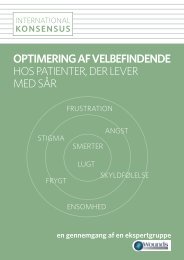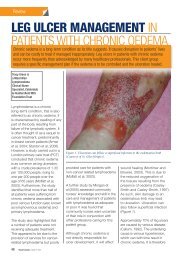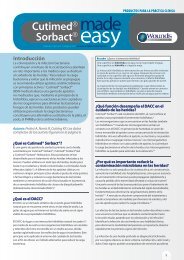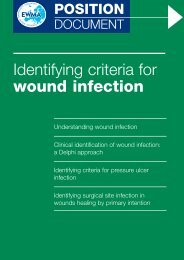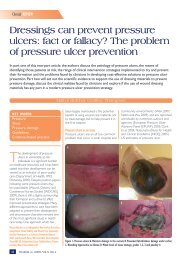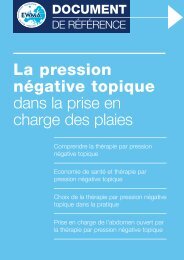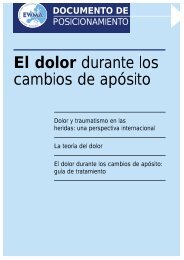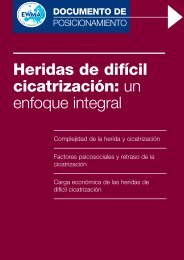VIEW PDF - Wounds International
VIEW PDF - Wounds International
VIEW PDF - Wounds International
You also want an ePaper? Increase the reach of your titles
YUMPU automatically turns print PDFs into web optimized ePapers that Google loves.
Bibliografia<br />
1. Morykwas MJ, Simpson J, Punger K, et al.<br />
Vacuum-assisted closure: state of basic<br />
research and physiologic foundation. Plast<br />
Reconstr Surg 2006; 117(7 Suppl): 121S–126S.<br />
2. Banwell PE, Téot L. Topical negative pressure<br />
(TNP): the evolution of a novel wound<br />
therapy. J Wound Care 2003; 12(1): 22-28.<br />
3. Malmsjö M, Borgquist O. NPWT settings<br />
and dressing choices made easy. <strong>Wounds</strong><br />
<strong>International</strong> 2010; 1(3): Disponibile su:<br />
http://www.woundsinternational.com<br />
4. European Wound Management Association<br />
(EWMA). Position Document: Hard-to-heal<br />
wounds: a holistic approach. London: MEP<br />
Ltd, 2008. Disponibile su: http://www.<br />
woundsinternational.com/pdf/content_45.pdf<br />
5. European Wound Management Association<br />
(EWMA). Position Document: Topical negative<br />
pressure in wound management. London:<br />
MEP Ltd, 2007. Disponibile su: http://www.<br />
woundsinternational.com/pdf/content_46.pdf<br />
6. McCord SS, Naik-Mathuria BJ, Murphy KM, et<br />
al. Negative pressure therapy is effective to<br />
manage a variety of wounds in infants and<br />
children. Wound Repair Regen 2007; 15(3):<br />
296-301.<br />
7. Chariker ME, Gerstle TL, Morrison CS. An<br />
algorithmic approach to the use of gauzebased<br />
negative-pressure wound therapy as a<br />
bridge to closure in pediatric extremity trauma.<br />
Plast Reconstr Surg 2009; 123(5): 1510-20.<br />
8. World Union of Wound Healing Societies<br />
(WUWHS). Principles of best practice:<br />
Vacuum assisted closure: recommendations<br />
for use. A consensus document. London:<br />
MEP Ltd, 2008. Disponibile su: http://www.<br />
woundsinternational.com/pdf/content_37.pdf<br />
9. Llanos S, Danilla S, Barraza C, et al.<br />
Effectiveness of negative pressure closure in<br />
the integration of split thickness skin grafts: a<br />
randomized, double-masked, controlled trial.<br />
Ann Surg 2006; 244(5): 700-5.<br />
10. Braakenburg A, Obdeijn MC, Feitz R, et al. The<br />
clinical efficacy and cost effectiveness of the<br />
vacuum-assisted closure technique in the<br />
management of acute and chronic wounds:<br />
a randomized controlled trial. Plast Reconstr<br />
Surg 2006; 118(2): 390-400.<br />
11. Mouës CM, van den Bemd GJ, Meerding WJ,<br />
Hovius SE. An economic evaluation of the use<br />
of TNP on full-thickness wounds. J Wound Care<br />
2005; 14(5): 224-7.<br />
12. Leininger BE, Rasmussen TE, Smith DL, et al.<br />
Experience with wound VAC and delayed<br />
primary closure of contaminated soft tissue<br />
injuries in Iraq. J Trauma 2006; 61(5): 1207-11.<br />
13. Armstrong DG, Lavery LA; Diabetic Foot<br />
Study Consortium. Negative pressure wound<br />
therapy after partial diabetic foot amputation:<br />
a multicentre, randomised controlled trial.<br />
Lancet 2005; 366(9498): 1704-10.<br />
14. Hurd T, Chadwick P, Cote J, et al. Impact<br />
of gauze-based NPWT on the patient and<br />
nursing experience in the treatment of<br />
challenging wounds. Int Wound J 2010; 29(6):<br />
448–55.<br />
15. Park CA, Defranzo AJ, Marks MW, Molnar JA.<br />
Outpatient reconstruction using integra* and<br />
subatmospheric pressure. Ann Plast Surg 2009;<br />
62(2): 164-9.<br />
16. Apelqvist J, Armstrong DG, Lavery LA, Boulton<br />
AJ. Resource utilization and economic costs of<br />
care based on a randomized trial of vacuumassisted<br />
closure therapy in the treatment of<br />
diabetic foot wounds. Am J Surg 2008; 195(6):<br />
782-8.<br />
17. Wallis L. FDA warning about negative presure<br />
wound therapy. Am J Nurs 2010; 110(3): 16.<br />
Disponibile su: http://journals.lww.com/<br />
ajnonline/Fulltext/2010/03000/Readiness_<br />
of_U_S__Nurses_for_Evidence_Based.7.aspx#<br />
[accessed Nov 2010]<br />
18. Malmsjo M, Ingemansson R, Martin R, et al.<br />
Negative pressure wound therapy using gauze<br />
or polyurethane open cell foam: similar early<br />
effects on pressure transduction and tissue<br />
contraction in an experimental porcine wound<br />
model. Wound Rep Regen 2009; 17(2): 200-5.<br />
19. Campbell PE, Smith GS, Smith JM.<br />
Retrospective clinical evaluation of gauze<br />
based negative pressure wound therapy. Int<br />
Wound J 2008; 5; 280-6.<br />
20. Kaufman M, Pahl D. Vacuum-assisted<br />
closure therapy: wound care and nursing<br />
implications. Dermatol Nurse 2003; 4: 317-25.<br />
21. Bickels J, Kollender Y, Wittig JC, et al.<br />
Vacuum-assisted closure after resection of<br />
musculoskeletal tumors. Clin Orthop Relat Res<br />
2005; 441: 346-50.<br />
22. Shirikawa M, Isseroff R. Topical negative<br />
pressure devices. Arch Dermatol 2005; 141<br />
(11): 1449-53.<br />
23. Gerry R, Kwei S, Bayer L, Breuing KH. Silverimpregnated<br />
vacuum-assisted closure in the<br />
treatment of recalcitrant venous stasis ulcers.<br />
Ann Plast Surg 2007; 59(1): 58-62.<br />
24. Malmsjö M, Lindstedt S, Ingemansson R.<br />
Influence on pressure transduction when<br />
using different drainage techniques and<br />
wound fillers (foam and gauze) for negative<br />
pressure wound therapy. Int Wound J 2010;<br />
7(5): 406-12.<br />
25. Jeffrey S. Advanced wound therapies in the<br />
management of severe military lower limb<br />
trauma: a new perspective. Eplasty 2009; 9: e28.<br />
26. Argenta LC, Morykwas MJ. Vacuum-assisted<br />
closure: a new method for wound control and<br />
treatment: clinical experience. Ann Plast Surg<br />
1997; 38(6): 563-77.<br />
27. Rinker B, Amspacher JC, Wilson PC, Vasconez<br />
HC. Subatmospheric pressure dressing as a<br />
bridge to free tissue transfer in the treatment<br />
of open tibia fractures. Plast Reconstr Surg<br />
2008; 121(5): 1664-73.<br />
Questo articolo è stato supportato da<br />
Smith & Nephew<br />
Informazioni sugli autori<br />
Henderson V 1 , Timmons J 2 , Hurd T 3 ,<br />
Deroo K 4 , Maloney S 5 , Sabo S 6<br />
1. Responsabile clinico viabilità dei tessuti,<br />
Northumberland Care Trust, Regno Unito<br />
2. Responsabile per l’educazione medica,<br />
Smith & Nephew, Hull, Regno Unito<br />
3. Infermiere clinico, specializzato<br />
4. Infermiere clinico, specializzato<br />
5. Manager principale di progetto e sviluppo<br />
6. Infermiere clinico, specializzato; Nursing<br />
Practice Solutions, Toronto, Canada<br />
Per approfondire<br />
Malmsjö M, Borgquist O. NPWT settings and dressing choices made easy. <strong>Wounds</strong> <strong>International</strong> 2010; 1(3).<br />
Disponibile su: http://www.woundsinternational.com<br />
Ousey K, Milne J. Negative pressure wound therapy in the community: the debate. Br J Community Nurs 2009;<br />
14(12): S4, S6, S8-10.<br />
Per citare questo articolo<br />
Henderson V, Timmons J, Hurd T, Deroo K, Maloney S, Sabo S. NPWT in everyday practice Made Easy. <strong>Wounds</strong><br />
<strong>International</strong> 2010; 1(5). Disponibile su: http://www.woundsinternational.com<br />
© <strong>Wounds</strong> <strong>International</strong> 2010<br />
6




